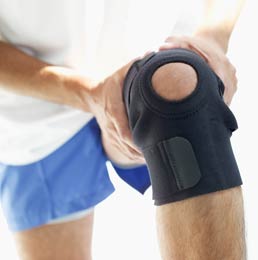
You may know that uh-oh sensation — the feeling of your knee suddenly giving way as you walk. That’s a sign of instability in the joint, and it can lead to increased discomfort. If this happens, contact your doctor as soon as possible. He or she may recommend knee braces and special orthoses (insoles that fit in your shoes, sometimes with extra ankle support) to help counter this instability. In the process, they may decrease pain or improve your ability to get around.
Surprisingly few studies have taken a close look at the benefits of braces and orthoses for people with knee osteoarthritis. A review of the research to date turned up only two well-controlled studies of braces and three of orthoses (Cochrane Database of Systematic Reviews, January 2005). Based on that limited evidence, the reviewers concluded that the devices have a small, but significant, beneficial effect.
A knee brace can help stabilize the knee, correct alignment of the leg and shift weight away from the affected part of the joint. There are different types of braces, but all are made from some combination of metal, foam, plastic, elastic material and straps. The reviewers found that wearing a knee brace may increase the distance that people with knee osteoarthritis are able to walk.
Orthoses are special insoles that change the alignment of the foot and redirect weight away from the affected area of the knee. The reviewers found that wearing certain types of orthoses, for example insoles with elastic strapping, may lead to decreased pain and better function.
People often turn to such devices when osteoarthritis is restricted to just one part of the knee and physical activity is limited by knee pain or instability, even after trying other treatment methods. Some people who use the devices are not good candidates for knee replacement surgery due to age or medical reasons. Others want to buy some more time before surgery is necessary.
Braces and orthoses often take some getting used to. If the fit isn’t right, they can lead to skin chafing or discomfort in the knee, low back or sole of the foot. Poorly fitted braces also may restrict the use of nearby joints, inadvertently causing further damage. But working closely with your health care providers can help ensure a good fit.
To get the best results, it’s important to wear braces or orthoses exactly as prescribed. If you leave them at home too often — for instance, because you don’t like the way a brace looks or an orthosis feels — you may not get the full benefit.
Generic knee braces and shoe inserts are sold at pharmacies, medical supply houses and sporting good stores. In some cases, though, your doctor may recommend buying a custom-molded, individually designed device.
While custom devices are more expensive than off-the-shelf ones, they may last longer and be more effective for treating difficult problems. Your doctor can help you decide whether the extra expense is justified for you. Also, check with your insurance company to find out how much, if any, of the cost is covered and whether there are any restrictions — for instance, on the type of health care provider you go to for the design and fitting.
PLEASE NOTE: The studies and their findings that are presented in this article are for informational purposes only and are not meant to take the place of the advice of your doctor. By providing you with this information, Sanofi is not endorsing its content nor does it represent that the information is necessarily appropriate for you. You should consult with your doctor before starting any new health or exercise regimen.
References“Benefits of bracing.” Arthritis Foundation. Available at: http://www.arthritis.org/benefits-bracing.php. Accessed September 6, 2011.
"Braces and Orthoses for Treating Osteoarthritis of the Knee (Review).” R.W. Brouwer et al. Cochrane Database of Systematic Reviews. January 24, 2005, issue 1, article no. CD004020.
"How do braces work?” Arthritis Foundation. Available at: http://www.arthritis.org/how-braces-work.php. Accessed September 6, 2011.
“When are braces used for OA?” Arthritis Foundation. Available at: http://www.arthritis.org/braces-used-oa.php. Accessed September 6, 2011.
“What to expect from a brace.” Arthritis Foundation. Available at: http://www.arthritis.org/expect-brace.php. Accessed September 6, 2011.
“Finding the right bracing solution.” Arthritis Foundation. Available at: http://www.arthritis.org/bracing-solution.php. Accessed September 6, 2011.
“Orthotics.” American Academy of Orthopaedic Surgeons. Available at: http://orthoinfo.aaos.org/topic.cfm?topic=A00172. Accessed September 6, 2011.
"Will insurance cover braces?” Arthritis Foundation. Available at: http://www.arthritis.org/insurance-braces.php. Accessed September 6, 2011.